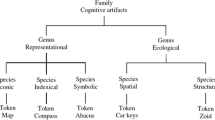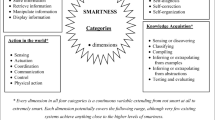Abstract
The computer is one of the most complex artifacts ever built. Given its complexity, it can be described from many different points of view. The aim of this paper is to investigate the representational structure and multifunctionality of a particular subset of computers, namely personal devices (PCs, laptops, smartphones, tablets) from a user-centred perspective. The paper also discusses the concept of “cognitive task”, as recently employed in some definitions of cognitive artifacts, and investigates the metaphysical properties of such artifacts. From a representational point of view, the article introduces the concepts of artifactual meta-representation and of semi-transparency, two features that personal devices share with some cognitive and non-cognitive artifacts. Recognising the meta-representational nature of personal devices and of other cognitive artifacts, thus overcoming semi-transparency, is important for the understanding of why different artifacts offer us different cognitive affordances as well as different cognitive advantages. In this sense, it is not simply a theoretical achievement, but has some important practical consequences. In our highly technological world we can use different kinds of computers and artifacts for solving the same tasks, and we need to understand why some artifacts are better suited for some tasks than others. The ultimate characterisation of personal devices that emerges from this work is that of a sort of super-artifact. This special status is given to personal devices because of their distinctive features. They are in fact intrinsically multifunctional and meta-representational artifacts, with extremely variable structures. As super-artifacts, personal devices are characterised by macro-functionality and can be easily used as both cognitive artifacts and tools for other functions, depending on the kind of representations they instantiate.
Similar content being viewed by others
Notes
It is easy to acknowledge that, despite its name, the smartphone is actually a computer.
References
Brey, P. (2000). Theories of technology as extensions of human faculties. In C. Mitcham (Ed.), Metaphysics, epistemology and technology. Research in philosophy and technology (Vol. 19, pp. 59–78). Amsterdam: Elsevier.
Brey, P. (2005). The epistemology and ontology of human–computer interaction. Minds and Machines, 15, 383–398.
Brey, P. A., & Soraker, J. (2009). Philosophy of computing and information technology. In A. Meijers (Ed.), Philosophy of technology and engineering sciences. Amsterdam: Elsevier.
Carrara, M., & Mingardo, D. (2013). Artifact categorization. Trends and problems. Review of Philosophy and Psychology, 3(4), 351–373.
Carroll, J. B. (1993). Human cognitive abilities: A survey of factor-analytic studies. Cambridge: Cambridge University Press.
Casati, R. (2017). Two, then four modes of functioning of the mind: Towards an unification of “dual” theories of reasoning and theories of cognitive artifacts. In J. Zacks & H. Taylor (Eds.), Representations in mind and world (pp. 7–23). London: Routlege.
Cummins, R. (1975). Functional analysis. Journal of Philosophy, 72, 741–765.
Fasoli, M. (2017). Substitutive, complementary and constitutive cognitive artifacts: Developing an interaction-centered approach. Review of Philosophy and Psychology. https://doi.org/10.1007/s13164-017-0363-2.
Heersmink, R. (2013). A taxonomy of cognitive artifacts: Function, information, and categories. Review of Philosphy and Psychology, 4, 465–481.
Heersmink, R. (2014). The metaphysics of cognitive artifacts. Philosophical Explorations, 19(1), 1–16.
Hilpinen, R. (2011). Artifact. In E. N. Zalta (Ed.), The Stanford Encyclopedia of Philosophy (Winter 2011 Edition). https://plato.stanford.edu/archives/win2011/entries/artifact/. Accessed 15 Dec 2017.
Houkes, W., & Vermaas, P. E. (2010). Technical functions: On the use and design of artefacts (Vol. 1). Berlin: Springer.
Hutchins, E. (1999). Cognitive artifacts. In R. A. Wilson & F. C. Keil (Eds.), The MIT encyclopaedia of the cognitive sciences (pp. 126–128). Cambridge: MIT Press.
Kaptelinin, V., & Czerwinski, M. (2007). Beyond the desktop metaphor: Designing integrated digital work environments (Vol. 1). Cambridge: MIT Press.
Kornblith, H. (1980). Referring to artifacts. The Philosophical Review, 89(1), 109–114.
Millikan, R. G. (1984). Language, thought, and other biological categories: New foundations for realism. Cambridge: MIT Press.
Mueller, P. A., & Oppenheimer, D. M. (2014). The pen is mightier than the keyboard: Advantages of longhand over laptop note taking. Psychological Science, 25(6), 1159–1168.
Norman, D. (1991). Cognitive artifacts. In J. M. Carroll (Ed.), Designing interaction: Psychology at the human–computer interface (pp. 17–38). Cambridge: Cambridge University Press.
Norman, D. (1993). Things that make us smart: Defending human attributes in the age of the machine. New York City: Basic Books.
Peirce, C. S. (1935). The collected papers of Charles Peirce (Vol. 3). Cambridge, MA: MIT Press.
Preston, B. (1998). Why is a wing like a spoon, a pluralist theory of function. The Journal of Philosophy, 95(5), 215–254.
Preston, B. (2013). A philosophy of material culture: Action, function, and mind. New York: Routledge.
Roda, C. (2011). Human attention in digital environments. Cambridge: Cambridge University Press.
Sutton, J. (2010). Exograms and interdisciplinarity: History, the extended mind and the civilizing process. In R. Menary (Ed.), The extended mind (pp. 189–225). Cambridge, MA: MIT Press.
Wright, L. (1974). Functions. Philosophical Review, 82(2), 139–168.
Author information
Authors and Affiliations
Corresponding author
Rights and permissions
About this article
Cite this article
Fasoli, M. Super Artifacts: Personal Devices as Intrinsically Multifunctional, Meta-representational Artifacts with a Highly Variable Structure. Minds & Machines 28, 589–604 (2018). https://doi.org/10.1007/s11023-018-9476-3
Received:
Accepted:
Published:
Issue Date:
DOI: https://doi.org/10.1007/s11023-018-9476-3




